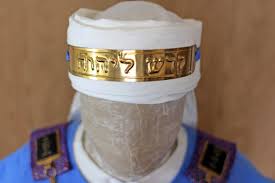Make a Plate and Engrave On It:
Holy to the LORD
28:36-38 and 39:30-31
Make a plate and engrave on it: Holy to the LORD DIG: How did the golden plate serve as a reminder? An exhortation? Hope? When was the turban and the royalty of Isra’el removed? What did it signal? When would it end?
REFLECT: Who stamps your sacrifices and gifts as HOLY TO ADONAI on your forehead? What insights does this give you into the role of Jesus as your High Priest?

The phrase: HOLY TO ADONAI was engraved on a plate of pure gold, the seventh piece of clothing, which in turn, was attached by a blue cord to the front of the turban worn by the high priest over his forehead. The turban was the sixth piece of clothing. The word plate stems from the root meaning to sparkle or to shine. The noun normally refers to a flower or a blossom, but here it refers to a shining object. The word holy in Hebrew, or godesh, means to be set apart, distinct or uncommon. Here it probably means that Aaron had been especially set apart for his ministry as high priest. The turban, which was wrapped around his head, was to be made of white twisted linen, pointing to righteousness and purity that must be visible in the one who stands in the presence of God, on the behalf of others.
The Hebrew word for turban is a feminine noun and is used exclusively in connection with the high priest, except for one instance where it symbolizes royalty (Ezeki’el 21:26). It never signifies the headgear worn by the common priesthood. A totally different word, headbands, is used for that (28:40).632
On his head was the golden plate, a sacred diadem, to remind him and the Israelites that their sacrifices and gifts were always to be brought to God in the proper way with the proper motivation. It was the seventh, and last piece of clothing. Therefore, the golden crown was the very essence of Isra’el’s worship. As the representative of the people, he bore their guilt when presenting their sacred sacrifices at the bronze altar in the courtyard or the golden altar of incense in the Sanctuary. The LORD’s people should always be holy in all they say and do.633
The priesthood started with Aaron in the desert, but it ended with Zedekiah, the profane and wicked king, in Jerusalem. Against the prophecy of Isaiah, King Zedekiah and Judah had rebelled against King Nebuchadnezzar and Babylonia. The result was that both the turban of the high priest and the crown of the king, were removed when Nebuchadnezzar destroyed Jerusalem in 586 BC. It marked the start of the time of the Gentiles (Luke 21:24). And as Ezeki’el prophesied: The turban and the crown would not be restored until Jesus, the Messiah, came to whom it rightfully belonged (Ezeki’el 21:26-27).
This prophecy points us back to Genesis 49:10, which speaks of the scepter in the line of Judah. The line of King David would not be restored until the righteous, God-appointed, King would come. There would be no valid claims until Jesus rode into Yerushalayim to claim His rightful rule (Zechariah 9:9; Matthew 21:1-11; Revelation 19:11-16, 20:4). Jesus Christ will completely fulfill Ezekiel’s prophecy. He will be both King and Priest of Isra’el.634 And just as the high priest wore his beautiful turban and plate of pure gold, one day Yeshua will be crowned with many crowns (Revelation 19:12).



Leave A Comment